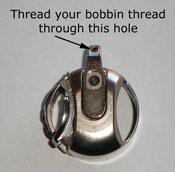This post contains affiliate links for which I receive compensation
Bobbin Thread Problems
My bobbin thread gets tangled on the bottom, and then snaps. It is the first time I've used monofilament thread.
What can I do to stop the bobbin thread from breaking?
I've tried tightening the bobbin tension, but that didn't work.
Reply
Since this is your first time with monofilament, I'm going to start at the beginning.This page "Machine quilting with clear thread" gives a good basic introduction to using monofilament thread in your sewing machine.
Is your bobbin neat?
My machine doesn't usually wind a nice, even firm looking bobbin. It look messy.Does yours?
If it does, use your hand to apply a little extra guidance so the thread winds onto it neatly and firmly. A messy bobbin and effect the tension because it'll feed unevenly into the stitch.
Monofilament as a bobbin thread
I'm not sure what you're using as a bobbin thread. If it's monofilament there are a couple of tricks to employ.If you've got plastic bobbins, you need to be particularly careful about winding thread onto them. Wind them slowly. If you wind fast, the thread stretches as you wind it, and that will effect your stitch quality later.
Fill bobbins about half full. Otherwise there's a tendency to over-fill and the plastic bobbin splits in two. I know that sounds weird, but it has happened to me more than once.
The reason I originally went to monofilament was to get more thread onto it. (Remember, to use size .004—really, really fine thread). But filling the bobbin half full kind of negates the value of clear thread in the bobbin.
These days I always use a 50wt or 60wt (Aurifil, Masterpiece or Prescenia) 100% cotton instead.
Check the bobbin case
If you've used clear thread here, there's a good chance you'll need to make bobbin tension adjustments.First, note of the position of the screw. I use a Post-It note, draw a circle on it and then note the crevasse on the screw's head. Adjust about an eighth of a turn at a time and test...turn right to tighten, and left to loosen the tension.
Monofilament stretches. You can prove it to yourself by holding a length of it between your hands and pulling on the ends. You can feel the stretch. You may need to reduce the bobbin tension, instead of increasing it, to accommodate for the increased tension it creates all on its own.
You said that your bobbin thread is all tangled on the bottom even after tightening the tension. Check the tension spring on your bobbin case. As you thread your bobbin-case, there's a spring or hook, something you are to 'catch' the thread on or in, that applies the tension.
It is quite possible that there's a piece of lint stuck in there holding the spring open so that no tension is applied to the bobbin thread. To clean it, take a piece of thread and literally 'floss' the spring or catch like you would your teeth.

If your case is a front load, there's another option for increasing bobbin tension without messing with the screw.
Just run your thread through the hole in the arm of the bobbin case as shown in the picture to the right. Just like your needle thread, adding a n extra 'guide' increases thread tension a bit.
If you are using monofilament in the bobbin, I suggest switching to one of the 50wt cottons mentioned above for now. Though you'll need to make tension adjustment to the needle thread, they won't be necessary for the bobbin. Once you are comfortable sewing and troubleshooting for clear thread in the needle, then you can add it back to the bobbin if you still want to.
Check the uptake arm
On my machine, clear thread has a pesky habit of 'jumping off' the uptake lever.When that happens, your needle tension goes all catawampus. And with no tension on the needle thread, there's no tension on the bobbin thread and it creates an ugly glob of thread throw-up on the bottom side of your quilt.
I make it a habit to check that this hasn't happened before I take my first stitch. I've found nothing to solve the 'jumping off' part of this problem. Remembering to check and correct before I start stitching is what works for me.
I hope this has given you some incites as to why this problem is happening and possible fixes.
Readers, do join in with your comments and suggestions using the 'Comment' link below.
Piecefully,
Julie Baird
Editor














